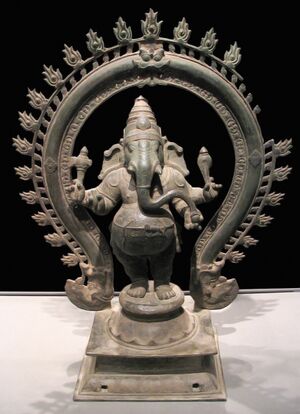Ganesha

In the teachings of Hinduism, Ganesha, or Ganapati, is the son of Shiva (the Third Person of the Trinity of the Godhead) and Parvati; in one legend Ganesha is the son of Parvati alone.
Ganesha is the god of wisdom, patron of learning and letters, and the chief of the many classes of minor gods who serve under Shiva. He is worshiped as the remover or destroyer of all obstacles; hence he is traditionally invoked at the beginning of any undertaking, religious or secular, and at the commencement of the writing of books or compositions to ensure the success of the endeavor.
Symbolism
Ganesha is depicted with the head of an elephant. Author Alain Daniélou explains that
Gaṇapati stands for one of the basic concepts of Hindu mythological symbolism, the identity of the macrocosm and the microcosm or, in religious terms, the notion that man is the image of God.... Gaṇapati is represented as an elephant-headed man to express the unity of the small being, the microcosm, that is man, and the Great Being, the macrocosm, pictured as an elephant.[1]
The elephant head is a very mystical awareness of the mind of God. This is the great virtue of the elephant: immense physical strength combined with almost infinite memory. There, that memory is a focal point symbolic of the cosmic computer. The elephant is quite apparent and present in India, not foreign to one’s concept, so it represents a virtue.
Ganesha then, as in all of the Hindu deities, becomes a personification of a God consciousness. The name itself is evocative of the light and that energy. The visualization of the elephant form is as good as any, because God is everything and all things. So when you say, “Why an elephant?” the Hindu would say, “Why not an elephant!” It’s all in our conceptualization. The elephant in its absurdity forces us to transcend the form, whereas if we were looking at the image of perfect God, we might fall in love with that God and be consumed by our own idolatry.
Therefore, there is that obvious point of a quantum leap that is taken. One looks at this Ganesha, God in disguise, and one smiles and is liberated from the form, goes behind the form, into a very cosmic sense of not only a person of the Holy Ghost but a very infinite principle. It is an energy, a light, and yet a person with whom you can converse, talk to about the project you are about to begin, the cycle you are about to start.
Ganesha and the Great Divine Director
The Great Divine Director is a cosmic being noted by his great causal body, in which he ensouls the memory, the blueprint, the mind of God for all evolutions of this outbreath of the Godhead. In the ascended masters’ lexicon and understanding, we speak of the Great Divine Director. In Hinduism, they speak of Ganesha. When you meditate upon both vibrations, you find that they are like two parts of a whole.
Meditation on Ganesha leads you to this infinite storehouse of the blueprint of the mind of God. When you contact that blueprint, you have contacted the core spiral of energy that must be released out of the nucleus of the atom of your own I AM Presence for you to begin whatever project you are beginning in the service of God. You can make the same contact through the ascended master the Great Divine Director, who himself, as you might say, becomes Ganesha, becomes that mind, that cosmic computer.
See also
Sources
Pearls of Wisdom, vol. 31, no. 65, October 2, 1988.
Pearls of Wisdom, vol. 35, no. 38, September 20, 1992.
Elizabeth Clare Prophet, April 19, 1979.
- ↑ Alain Daniélou, The Gods of India: Hindu Polytheism (New York: Inner Traditions International, 1985), pp. 292, 293.
